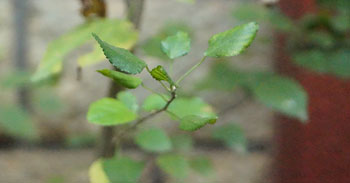KJC Medicinal Garden
Indian acalypha
Acalypha indica
Order: Malpighiales
Family: Euphorbiaceae
Genus: Acalypha
Species: A. indica
Common Names: Indian Acalypha, Indian Mercury, India Copperleaf, Indian Nettle, Three-seeded Mercury
Native to Nigeria in West Africa (Old World tropics), India, South East Asia, Yemen, and Oceania (New World Tropics)
Other plants of the same genus with medicinal properties
-
A. bailloniana
A. canescens
A. caroliniana
A. chinensis
A. ciliata
A. cupamenii
A. decidua
A. fimbriata
A. minima
A. somalensis
A. somalium
A. spicata
- Shrub growing up to 40-75 cm, erect, simple or branched, slightly hairy annual herb.
- They are species of plant having catkin type of inflorescence
- Stems are hairy
- Leaves: ovate leaves
Uses in Tradition systems of medicine
- It is an effective source of traditional and modern medicines.
- About 80% of rural population depends upon the herbal medicine for their primary health care.
- Useful in treating pneumonia, asthma, rheumatism and several other aliments.
- Dried leaves of Acalypha indica was made into a poultice to treat bedspores and wounds.
- Acalypha indica root is prescribed as tonic, astringent, febrifuge and strong purgative.
- Leaves posses anti periodic and laxative properties, the leaves are used in jaundice, piles, ulcers and also externally skin eruptions, ring worms, eczema.
- The roots are used in chest pain, joint pain, and migraine and blood dysentery and the extract of the root lowered the blood sugar level up to 30%.
- Other properties include anti-inflammatory, anthelmintic, anti-bacterial, anti-fungal, anti-oxidant, neuro-protective, anti-venom and antiulcer activity.
- The plant contains phenolic compounds such as flavonoids, steroids, tannins, and saponins.
- Their leaves contain the highest moisture: 9.49%, ash: 12.83%, protein: 23.98%.
- The root contains the highest carbohydrate: 76.33%, crude fibre: 42.25, and gross energy: 1453.94 kJ, root also have lowest fat content of 0.54+0.17%
Suggested Medicinal Properties
- Anti-inflammatory
- Anthelmintic
- Antibacterial activity
- Antifungal activity
- Anti-oxidant
- Neuro-protective
- Anti-venom activity
- Antiulcer activity
- Analgesic
- Anti-cancer activity
- Anti-diabetic activity
- Anti-viral activity
Active Phytochemicals
1. Acalyphamide (N- [2-(4- hydroxyphenyl) ethyl] dotriacon tanamide)
2. Acaindinin
3. Acetonylgeranin
4. Aurantiamide
5. Caffic acid
6. Corilagin
7. Cysteine
8. Ferulic acid
9. Gallic acid
10. Stigmasterol
11. Resin
12. Syringic acid
13. Tectoquinone
14. Triacetonamine
15. 3,3’ Methylene bis(4-hydroxyl coumarin)
References
Sundhakar Chekuri, Lali Lingfa, Shivaprasad Panjala, K. C. Sai Bindu and Roja Rani Anupalli. “Acalypha indica L. – an Important Medicinal Plant: A Brief Review of its Pharmacological Properties and Restorative Potential.” European Journal of Medicinal Plant 31(11):1-10,2020; Article no. EJMP.58589
Nurul Nadia Mohad Nazri, Norazlanshah Hazali, Muhammad Ibrahim, Mashita Masri, Mohd Khan Ayob. “Preliminary Studies on Acalypha indica: Proximate analysis and Phytochemical Screening.” International Journal of Pharmacy and Pharmaceutical Science vol *, Issue 3, 2016.

